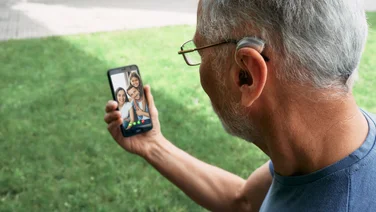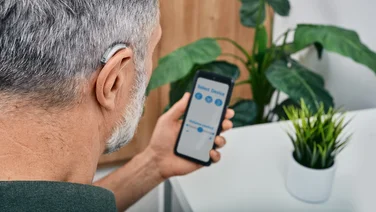To help us provide you with free impartial advice, we may earn a commission if you buy through links on our site. Learn more

It’s a small wonder that rechargeable hearing aids have become so popular so quickly: fiddling with tiny batteries is among the most annoying things about owning a most types of hearing aid. The disposable button batteries that power traditional hearing aids need replacing every few weeks at least, or as often as every few days if you’re a high-power user.
Rechargeable hearing aids aren’t hearing aids that take rechargeable batteries. You can’t actually get rechargeable batteries in the size required. Instead, these rechargeable devices power up like electric toothbrushes, via contact with a charging surface. All you do is pop your rechargeable hearing aids into a special charging case for anything from half an hour to overnight.
Below, we’ll reveal some of the best rechargeable hearing aids you can currently buy. First, here’s our in-depth guide to the pros and cons of rechargeable hearing aids, including their features, their availability and their cost.
If you have an idea of your needs, use our free quote finder tool to be matched to a local hearing aid specalist and find the best hearing aids for you.
Get a free quote for hearing aids today
Find out how much hearing aids could cost you by taking our quick survey.
How do rechargeable hearing aids work?
Rechargeable hearing aids work in the same way as non-rechargeable hearing aids, except that they’re powered by built-in lithium ion (or, less commonly, silver zinc) batteries that don’t need to be replaced or thrown away.
All rechargeable hearing aids charge by contact with a port or case, which is in turn plugged into the mains via a USB-to-mains cable. Many users find it convenient to keep their hearing aids in the charging case overnight, so they’re always ready for action in the morning.
Most hearing aid charging cases retain some power in their on-board battery, so they effectively double as portable power banks. The amount of charge a case retains varies quite a bit, though. Some of the best cases can store enough residual power for three full charges.
READ NEXT: How do hearing aids work?
What are the advantages of rechargeable hearing aids?
The big advantage is convenience, because they do away with the need to buy and replace tiny disposable batteries every few days or weeks. Many of us are so used to charging our phones, laptops, earbuds and toothbrushes that charging our hearing aids seems completely natural.
Other advantages include…
Easier handling: If you have dexterity issues and don’t like having to constantly remove and replace tiny hearing aid batteries, a switch to rechargeables can be a big relief. What’s more, a pile of spent disposable batteries can be a real pain, and heavy, to carry to the supermarket for pouring into those special battery bins.
Better for the environment: Disposable batteries are not just waste, they’re hazardous waste, and they need to be disposed of in the right way via the right places.
Safety: Button batteries are dangerous if they’re swallowed by pets or small children, and this happens worryingly often. With rechargeable hearing aids, the batteries are sealed inside the device. Just don’t let your dog swallow your hearing aid!
How long do rechargeable hearing aid batteries last?
Hearing aids are sophisticated little devices that chomp through power, especially if you need plenty of audio enhancement for hours each day. So in terms of battery life, they’re more like smartphones than electric toothbrushes, lasting a day rather than weeks before they need charging.
Current generations of rechargeable hearing aids with lithium-ion batteries can hold a charge for up to 30 hours, depending on the high-power features you use. High-power features include greater levels of amplification or sound enhancement, plus extra functions such as Bluetooth and mobile streaming.
The batteries inside rechargeable hearing aids have about the same lifespan as the hearing aids themselves (around five years for lithium ion devices), so you’re unlikely to have to replace the built-in battery at any point. That said, most hearing aid manufacturers will replace the battery if it dies while the hearing aids are still working well.
How long do rechargeable hearing aids take to charge?
Three or four hours in a standard charging case is enough to fully charge most hearing aids, so many users leave them docked in the case overnight. About 30 minutes in the charging case gives a few hours of battery life.
How can I charge my hearing aids faster?
All rechargeable hearing aid manufacturers make a range of charging cases, so you can upgrade your standard charging case if you want. Just make sure the new case is compatible with your model of hearing aid.
If you need a faster charge, invest in a speed charger such as the Starkey Mini Turbo Charger (£105 from Hearing Aid Accessories), which works with Starkey Livio and Livio AI hearing aids. It claims it can charge a flat battery to 20% in just seven minutes, giving a few hours of hearing aid use. The charger can also retain enough power for four full charges without needing to be plugged into the mains.
Replacement charging cases are widely available from stores such as Hearing Aid Accessories and Hearing Direct. They cost around £50-£150 for standard mains chargers, or more for turbo, wireless and portable chargers.

What are the disadvantages of rechargeable hearing aids?
Rechargeable hearing aids aren’t for everyone. Here are their main downsides…
They lose power faster than disposable batteries. If you have severe hearing loss and need to be socially or professionally active around other people all day, then you may need the extra power disposable batteries give you.
Having said that, rechargeable hearing aid technology is progressing fast, and many models stay charged even when you’re using high-power features all day.
Dependency on a charging unit will put some people off. If you want to be able to charge your hearing aids when you’re away from home, you will need to remember to take the charging case with you.
Fewer hearing aid styles to choose from. Until recently, you could only get rechargeable hearing aids in behind-the-ear (BTE) models, rather than the more discreet in-the-ear (ITE) styles. You can get ITE rechargeable hearing aids now, but the range is not quite as wide as with non-rechargeables.
You’ll need to upgrade your hearing aid. With an increasing number of exceptions, such as the retrofittable Oticon OpnS miniRITE, most traditional hearing aids can’t be turned into rechargeable hearing aids just by adding rechargeable batteries. So you’ll need to go through the process of choosing a new hearing aid model again.
How much do rechargeable hearing aids cost?
Rechargeable hearing aids do tend to have a higher upfront cost than non-rechargeables. For example, the cheapest rechargeable hearing aid from Specsavers is the Advance Standard (£995/pair), while the cheapest non-rechargeable costs £495/pair. The cheapest ITE model we found, the Signia Active, costs £599/single or £999/pair from Hearing Direct.
The difference in price is often down to other features. Rechargeables tend to have more sophisticated functions like wireless connectivity and mobile audio streaming. You also get a free charging case.
When you try to compare like with like, rechargeability on its own only adds about £100 to the price. Many rechargeable hearing aids in Specsavers’ range have a non-rechargeable option for £100 off.
Rechargeable hearing aids can actually save you money over their lifetime by avoiding the need to buy disposable batteries. Disposable batteries for hearing aids cost around £3 per month, which adds up to £180 over the potential five-year life of rechargeables.
READ NEXT: Specsavers hearing aid prices, explained
Can I get rechargeable hearing aids on the NHS?
Yes, rechargeable hearing aids are available on the NHS in the UK, but it’s a bit of a lottery. Availability depends on many factors including your individual hearing needs, resources available in your local area, and the decisions made by local clinical commissioning groups (CCGs).
This may help to explain why a 2021 survey of hearing aid providers found that over two-thirds (68%) of private patients had rechargeable hearing aids, while a tiny 0.5% of NHS patients had rechargeables. The main reason audiologists were moving towards rechargeable hearing aids, said the report, was environmental concern.
How do I choose the best rechargeable hearing aid for me?
Choosing the best hearing aid for you requires the help of a trained audiologist who can advise on the many factors that best suit you and your level of hearing loss. Most of these factors will be the same if you’re choosing rechargeable or non-rechargeable hearing aids, such as your budget, the style of hearing aid, and audio features such as listening environments and spatial awareness.
Here are some additional factors to discuss if you’re choosing rechargeable hearing aids:
Charge time – and time to charge. Do you need a hearing aid that lasts all day at high amplification, and do you want to be able to recharge it quickly? The ReSound Omnia (£1,795/single or £3,395/pair from Richmond Hearing) is a premium model in this area, taking three hours to fully charge, then staying charged for “a comfortable 30 hours of wear”, according to the testers at Hearing Aid UK.
Charging case. Some cheaper models have to be plugged into the mains to deliver any charge, so it’s worth mentioning if you want a power bank-style case.
Health tracking features such as heart rate sensors and step trackers are included in many rechargeable hearing aids, such as the Phonak Audeo Fit Paradise (£2,995/pair from Boots). Features like this can increase the price, but for many people they make their hearing aids an even greater boon to their quality of life.






